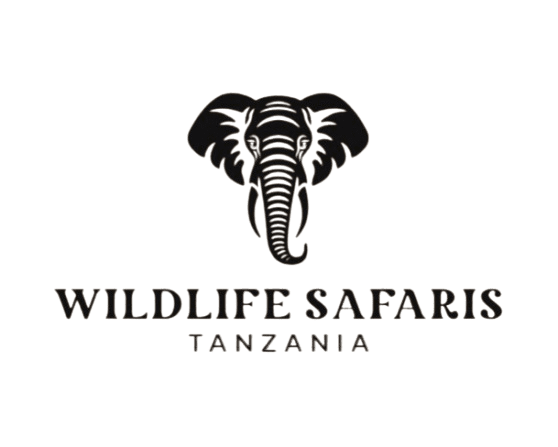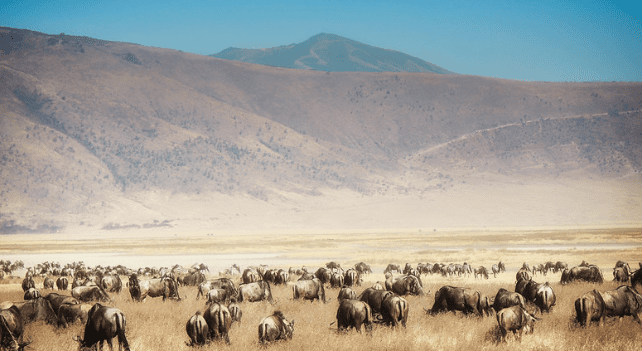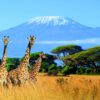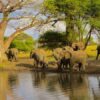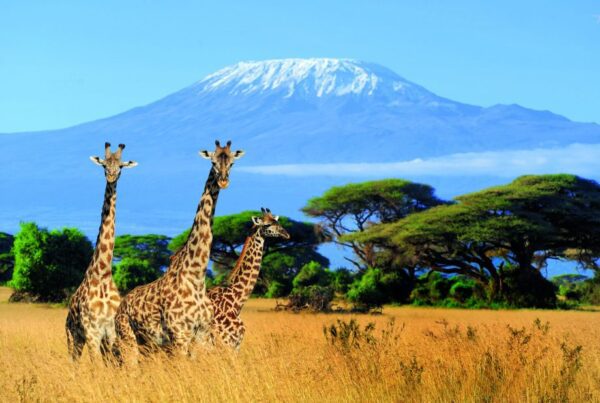NGORONGORO CONSERVATION AREA
This is an essential stop for every tourist visiting the Serengeti, at least according to most people. Unlike parks, which are overseen by the Tanzania Parks Authority, the Ngorongoro Conservation region Authority (NCAA) was responsible for the establishment of this protected region in 1959. Which is why its rules and costs are slightly different from the parks’. The drive from Arusha will take around five hours to reach the destination. The journey to Ngorongoro often includes stops at many attractions. Alternately, the Ngorongoro Conservation Area (NCA) has two airstrips—Ndutu Airstrip and Ngorongoro Airstrip—that visitors may use to fly in from Arusha.
Located in Tanzania’s Northern Circuit safari zone, adjacent to the Serengeti in the east, the NCA covers 8,292 square kilometers (3,202 square miles). In addition to animals, the Maasai people call the NCA home and utilize it as a pasture for their cattle. And many tourists are captivated by the notion that these charming towns have thrived despite the presence of ferocious predators like lions.
What time of year is ideal for a visit to Ngorongoro Conservation Area?
Is the optimal time to visit Ngorongoro on your bucket list? Because the most desirable Big 5 animals congregate around water sources during the dry season (June–October) in the Ngorongoro Crater, this is the ideal time to go wildlife viewing. Stunning vistas of the crater will also be revealed to you. The months of November through May are not the best time to visit the area because of the abundance of colorful birds and verdant vegetation, which may make it difficult to observe wildlife. During your stay during the wet season, you may have the opportunity to see the awe-inspiring calving of the wildebeest in the Ndutu region. This UNESCO World Heritage site is very spectacular at any time of year.
The Ngorongoro Crater, the world’s biggest complete caldera, is the NCA’s main attraction. With an area of 264 square kilometers, it has a diameter of 19 km. From its 600-meter-tall crater rims, sightseers may take in the sunset while observing the local fauna.
This crater is inhabited by all five of the Big Five. Curiously, compared to the Serengeti, the crater makes it easier to see all five. The size difference between Serengeti and Ngorongoro Crater is the main cause for this observation. Rare as rhinos are in the Serengeti, you’re more likely to see them if you drive on the bottom of the crater.
Also, the crater is home to some of the world’s most varied animals. The crater provides herbivores and predators with food, water, and shelter, so it’s no surprise that almost every sort of animal lives there. But there’s one caveat. There are no giraffes in that area. These higher creatures have a tougher time going down and up the steep crater edges. Giraffes are browsers, not grazers; the grasslands that make up the crater bottom are also mostly devoid of trees. The Ngorongoro Crater becomes an increasingly hostile environment as a result.
The NCAA is home to an abundance of bird species. This region is home to more than 500 species. You get the chance to encounter some of Tanzania’s unique rare birds. Between the months of November and May, you may see migratory birds settling in for breeding season. Among the many magnificent species found here are flamingos, herons, ostriches, hamerkops, secretary birds, Kori bustards, and countless more.
Ngorongoro offers a plethora of exciting experiences beyond just game drives. Walking safaris in the Highlands get you up close and personal with animals like rhinos and lions on guided tours of the crater. When you visit a place that allows walking safaris, you may explore the area on foot and see all sorts of unique plants and creatures. Arrange a morning hot air balloon tour to get a bird’s-eye view of the caldera, crater, and animals. During the golden hour, photographers will love the vibrant hues, and at night, you can see the stars from the crater rim lodges, making for a memorable experience. Lastly, in addition to wildlife drives, cultural tourists to Ngorongoro may learn about the Maasai culture, who are an integral part of the park’s offerings. Visiting traditional Maasai settlements is a wonderful way to round off a safari in Ngorongoro. Traditional clothing for shukas and rubegas, as well as dancing and cow herding techniques, are taught there. Beads, sandals, baskets, and other goods are made by the skilled craftsmen, weavers, and smiths among the Maasai. You can encourage their imagination.
We provide a variety of lodgings for your Ngorongoro visit, so you can make the most of it. Guests at five-star resorts like Ngorongoro Serena Safari Lodge may enjoy contemporary amenities and breathtaking views of the crater. Budget campgrounds, meanwhile, provide a once-in-a-lifetime opportunity to enjoy nature. Safaris to Ngorongoro aren’t complete without visiting neighboring parks, such as Serengeti National Park to witness the Great Migration or Lake Manyara to see flamingos and tree-climbing lions. You can reach each of them in a day or two by car. For a taste of cultural and scientific research, don’t miss Olduvai Gorge, a historic site showing early human remains.
